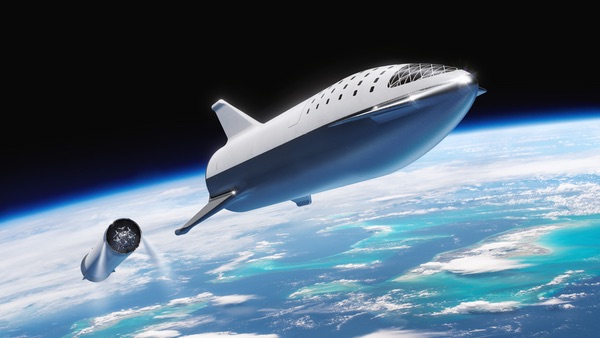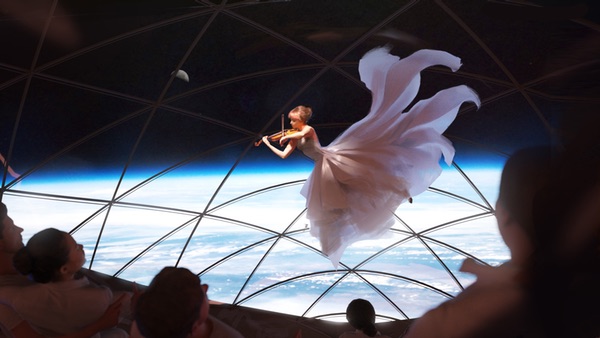
SpaceX’s BFR gets closer to Mars, by way of the Moonby Jeff Foust
|
| “I think it looks beautiful,” Musk said of the revised design. “I love the Tintin rocket design, so I kind of wanted to bias it towards that.” |
A year later, Musk returned to the IAC, held in Australia, for an update on the system, now officially called the Big Falcon Rocket. The BFR was somewhat downsized from the concepts displayed in Mexico, but the ambitions were still just as large: humans to Mars as soon as 2024. This time, the event was more orderly, but without any question-and-answer period (see “Mars mission sequels”, The Space Review, October 2, 2017)
Musk is currently not on the schedule, though, to speak at this year’s IAC, which takes place next week in Bremen, Germany. Instead, he used an event last week on home turf—SpaceX’s factory in Hawthorne, California—to announce more changes to the BFR design as well as a unique customer for the one of the BFR’s first missions.
 Design changes in the BFR spaceship include aft fins that incorporate landing legs and two movable fins in the front. (credit: SpaceX) |
The changes to the BFR rolled out at the event focused primarily on the upper stage, or “spaceship,” portion of the vehicle, sometimes called BFS. The spaceship section is now 55 meters long, about seven meters longer than the previous iteration of the design announced last year. The interior volume of the crew cabin in the spaceship will now be in excess of 1,000 cubic meters, Musk said. “I think it will probably end up being something around 1,100 cubic meters,” he said.
The propulsion and control surfaces of the BFR spaceship are also different. The aft section now sports three large fins that incorporate landing legs. Two of those fins are movable, as are two new fins near the front of the vehicle. “The way BFR flies is somewhat counterintuitive,” he said, showing a simulation of the vehicle entering an atmosphere for landing and likening it at one point to a skydiver. “You kind of want four control surfaces to be able to control the vehicle through a wide range of atmospheric densities and velocities.”
Last year’s BFR spaceship design featured six of the Raptor methane/liquid oxygen has under development, four of which had vacuum-optimized nozzles. The new design now features seven engines, all with the same nozzle as will be used on the booster section. Musk indicated the company was trading off optimizing engine performance for streamlining engine development. “In order to minimize the development risk and cost, we decided to ‘commonize’ the engine between the booster and the ship,” he said.
He didn’t rule out, though, adding vacuum-optimized versions of Raptor to future versions of the spaceship, putting them in place of cargo racks ringing the base of the vehicle. “Your total payload to Mars would increase significantly,” he said. “But we can do 100 tons to the surface of Mars with those [current] engines.”
Those changes are intended to improve the vehicle’s performance, particularly during atmospheric entry, but Musk said other factors played into that redesign. “I actually did not like the aesthetics of that design,” he said, which featured two smaller flaps and six landing legs. “I think this design is probably on par with the other one. It might be better. It’s slightly riskier, technically, because of coupling legs and the actuating wing-fin-flaps. But I think it’s the right decision overall.”
“I think it looks beautiful,” he added. “I love the Tintin rocket design, so I kind of wanted to bias it towards that.”
| “Finally, I can tell you that I choose to go to the Moon,” Maezawa said, echoing the lines of President John F. Kennedy more than a half-century ago. |
Despite the evolving design, production of hardware for the first spaceship is in progress. Musk showed of photos of the “main cylinder section” of the spaceship, nine meters in diameter, being fabricated. “We’ll be building the domes and the engine section soon,” he said. Initial “hop” tests of the vehicle are planned to start at the company’s South Texas launch site under construction as soon as late next year.
Musk also offered a cost estimate for developing the overall BFR system: “on the order” $5 billion, an estimate he suggested was still pretty rough. “I don’t think it’s more than ten, and I don’t think it’s like less than two” billion dollars, he said.
 Yusaku Maezawa plans to include several artists with him on his flight around the Moon, but details for selecting them remain to be determined. (credit: SpaceX) |
And where will that $2 to 10 billion come from? “Funding BFR is definitely a key question,” he said, ticking off various funding sources from satellites and commercial cargo and crew missions to SpaceX’s proposed Starlink broadband satellite constellation, which the company has previously suggested will ultimately be the biggest revenue generator for the its Mars ambitions.
“Private customers, or any customers for BFR, are incredibly helpful in funding the development of the rocket,” he added. With that, he introduced the “first paying customer for BFR,” who the company said in the announcement of the event a few days earlier would be going on a circumlunar mission.
That customer is Yusaku Maezawa, a 42-year-old former musician who founded Zozotown, a Japanese online fashion retail site. His stake in the company gives him an estimated net worth of about $3 billion, according to Forbes.
“Finally, I can tell you that I choose to go to the Moon,” he said, echoing the lines of President John F. Kennedy more than a half-century ago. “I’m really excited, really honored.”
That announcement, though, came with a twist. Maezawa would not be going to the Moon alone. Instead, he purchased an entire flight of the BFR, and planned to fly with him a group of six to eight artists on a project called “#dearMoon”.
“Since I was a kid I have loved the Moon,” he said. “That is why I could not pass up this opportunity to see the Moon up close. At the same time, I did not want to have such a fantastic experience by myself. That would be a little lonely.”
“I choose to go to the moon with artists. I choose to invite artists from around the world on my journey,” he said.
How those artists will be invited and selected remains to be determined: the announcement offered few specifics about the process, other than Maezawa was casting a wide net and would provide regular updates.
| “It’s not 100 percent certain that we succeed in getting this to flight,” Musk said. “I think it’s pretty likely, but it’s not certain. But we’re going to do everything humanly possible to bring it to flight as fast as we can and as safely as we can.” |
What he is providing is funding to support continued work on BFR, including an initial down payment. Neither Maezawa nor Musk would disclose a specific figure but Musk said it was significant. “It will actually have a material effect on paying for the cost of development of BFR,” Musk said. “It’s a non-trivial amount. It’s a material impact to the BFR program. It makes a difference.”
“He is ultimately helping pay for the average citizen to be able to travel to other planets. It’s a great thing,” he said of Maezawa.
That circumlunar trip is planned for 2023, but SpaceX schedules have slipped in the past, something Musk acknowledged. “We’re definitely not sure” about that 2023 deadline, he said. “I think we’ve been pretty unsure about prior dates, too.”
“You have to set some kind of date that’s the things-go-right date, and then, of course, we have reality, and things do not go right in reality,” he said. “There’s so many uncertainties. I mean, this is a ridiculously big rocket, it’s got so much advanced technology.”
He hesitated for a moment, then continued. “It’s not 100 percent certain that we succeed in getting this to flight,” he said. “I think it’s pretty likely, but it’s not certain. But we’re going to do everything humanly possible to bring it to flight as fast as we can and as safely as we can.”
As SpaceX moves forward, Musk also indicated that the tinkering of the BFR design seen this year and last year is coming to an end. “I feel like this is the final iteration, in terms of broad architectural decisions, for BFR/BFS,” he said.
But, if Musk and SpaceX are planning more changes, he can mark his calendar now: the 2019 International Astronautical Congress won’t be until October 21–25 of next year, in Washington, DC.
Note: we are temporarily moderating all comments subcommitted to deal with a surge in spam.